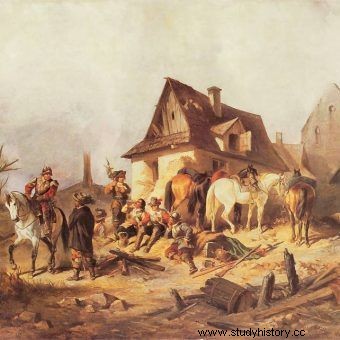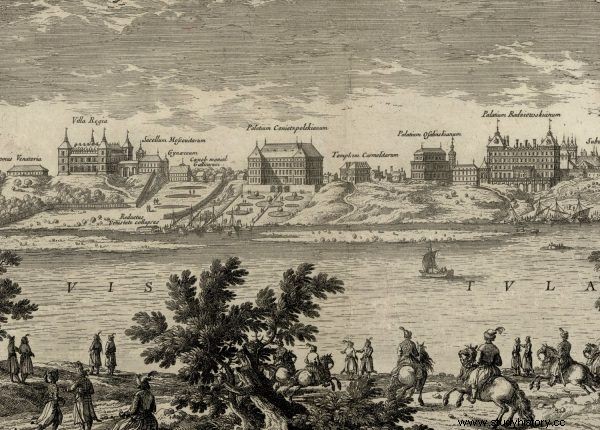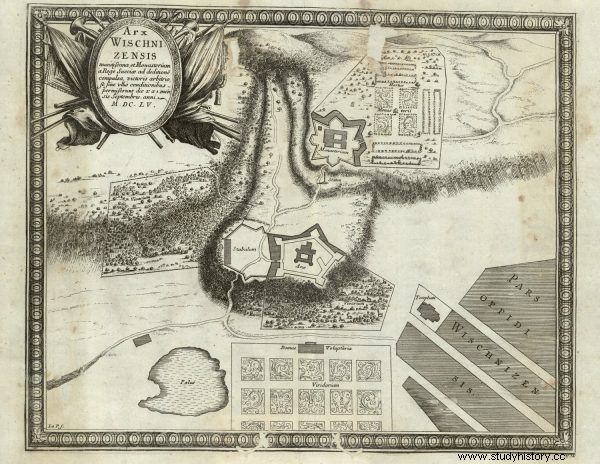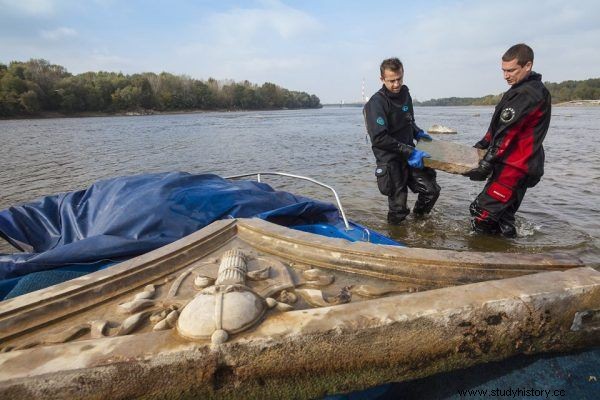After the attack of Karol Gustaw's army, the Republic of Poland looked like after the apocalypse. The Swedes, flooding Poland, were in no way inferior to the ancient barbarians. And for the Nazis and Red Army, who entered the Polish-Lithuanian Commonwealth a few centuries later, they could serve as an infamous example.
The deluge brought enormous destruction to the Republic of Poland, probably comparable only to the ordeal of World War II. The invaders in Poland behaved like Huns or Vandals. The country's population decreased by up to 40 percent. Of the ten million inhabitants, six remained. In Wielkopolska, where the army of Karol Gustaw stayed the longest, only half of the population survived.

During the Deluge, the Swedes plundered Poland almost completely. The illustration shows a fragment of Henryk Pilatti's painting "The Swedes".
Where does this barbarism come from in our northern neighbors? All because the then Sweden was ... poor as a church mouse. Its kings could only dream of luxurious mansions and furniture. The country had barely a million inhabitants, and its casket was empty. Mighty rulers lived modestly, feasting on wooden benches and tables without tablecloths. As the Swedish historian Herman Lindqvist recounts:
Sweden looked like a collapsed village. Shakespeare's plays were premiered in Stockholm 15 years later than in Warsaw . In Warsaw, they were shown by the famous Shakespearean theater, The Globe from Stratford-upon-Avon, and only third-rate theater troupes reached Sweden.
Gold scraped off the slats
In history, Scandinavians have plundered and destroyed Poland more than once. At the beginning of the 17th century, during the reign of Gustaw Adolf, they removed the Copernicus book collection from Frombork. In turn, at the end of this century, during the reign of Charles XII, they sometimes used archival Polish books as bedding for horses. The scale of the looting that took place during the Deluge, however, turned out to be incomparably greater. In 1655, the soldiers of Karol Gustaw, disheartened during the Thirty Years' War that had ended seven years earlier, attacked Poland like a hungry animal.

A soldier of Charles X Gustav pounced on Poland as a hungry animal.
The Swedes took literally everything. Pictures, jewelry, tableware, mirrors and tablecloths fell into their hands. Altars, crucifixes, chasubles, covers, organs, baptismal fonts and candlesticks, as well as cans, canopies and busts disappeared from churches. Larger items such as sculptures, fountains, plaques, epitaphs, regalia, and even ... bells were not spared. Marbles, bowls, pitchers and plates were very popular among the looters, but fireplaces were taken, floors and upholstery were torn off. Animal skins, dresses, military items, banners, tents, tapestries, carpets, and all kinds of furniture:wardrobes, armchairs, tables, chests, stairs, balustrades, window sills and doors - together with door frames were taken away. The soldiers, so as not to miss anything, even scraped off the gilding from the slats!
Interestingly, the loot from Polish churches was often taken to their own churches and stored there as pious gifts after a successful war expedition. The gains from Catholic Poland in the Protestant church had a symbolic value:here was the Reformation triumphed over the papists.
During the wars with the Republic of Poland, northern neighbors looted at least 17 archives and 67 libraries. Only during the Deluge did they remove the book collections from, among others, Poznań, Warsaw, Kraków, Toruń, Bydgoszcz, Grudziądz, Lublin, Sandomierz and Radom. Even the names of particularly active robbers have been preserved. For example, the Swedish diplomat Schering Rosenhane was responsible for looting the Jesuit book collections in Bydgoszcz and Toruń in 1656. Thanks to his military activity, he later boasted one of the largest libraries in Sweden.
Capital in ruin
After the Swedish occupation, Warsaw presented a picture of poverty and despair. The population of the capital decreased from fifteen thousand to six. The invaders ruined the bishop's palaces, the rich mansions of the Kazanowski, Ossoliński and Daniłowicz families, as well as the houses of the townspeople. They stole the castle and the royal palaces. As on November 8, 1655, the Polish king of Warsaw, Karol Gustaw, was informed:
ordered to tear up the upholstery in three palaces and remove the marble walls, dismantle the log cabin in the garden, consisting of 32 beautiful marble columns, which were broken when dismantled. But that's not enough:it tells you to take windows and panes .
After the war, the secretary of Queen Ludwika Maria described that “the Swedes contaminated the castle so much that it was uninhabitable. They even led the horses into the third floor chambers, which are full of dung and the bodies of fallen Swedish soldiers ". The residence was unusable, so Jan Kazimierz moved to Villa Regia (Kazimierz Palace). Even later, despite a quick renovation, it did not return to its former glory. King Michał Korybut Wiśniowiecki preferred to live in the Ujazdowski Castle, and Jan III Sobieski preferred Wilanów outside the period of parliamentary sessions.

Villa Regia visible on a fragment of the panorama of Warsaw by Erik Dahlberg.
Interestingly, the Swedes did not loot the Zygmunt column from Warsaw. Disassembling it turned out to be too difficult and there was no engineer who could cope with the task. It was very unpleasant to Karol Gustaw, who wanted to get rid of her, so that she would not remind us of the former Polish victories and the claims of the Vasa from the Vistula to the Swedish throne. When the idea of moving or removing the monument didn't work out, the Swedish king even considered blowing it up. Ultimately, he kept it with a view to a possible "exchange" for his captured Field Marshal Arvid Wittenberg.
Cultural desert
The flood wave also hit other cities. It didn't matter whether they defended or surrendered, or whether they were promised not to rob them or not. Krakow trusted the words of the invaders and paid dearly for it. The Scandinavians looted Wawel and the cathedral eight times! They ripped off the silver sheets from the altar of St. Stanisław, and silver nails were torn out from the coffin of Władysław IV. It was similar elsewhere. Of the larger centers in the Commonwealth, only Gdańsk and Lviv did not suffer during the invasion.
The castles were also ruined. The Swedes took 150 wagons full of loot from the Lubomirski residence in Wiśnicz, then partially blew it up. They also devastated Krzyżtopór, Czersk, Tenczyn, Lanckorona, Pieskowa Skała ... The Eagle's Nests from the times of Casimir the Great lay in ruins. Countless churches and monasteries were also robbed. Church and private collections were taken away.

The scale of the Swedish plunder is evidenced by the fact that only 150 wagons of stolen goods were removed from the castle in Wiśnicz.
Even smaller settlements did not avoid looting, because the army had to "feed itself" during long marches. As a result, as many as several hundred villages disappeared from the maps. In Greater Poland, three-quarters of the land was fallow, and in Mazovia no more than half of the fields were sown.
It is no exaggeration to say that wars with the Swedes turned Poland into an economic ruin and a cultural desert . "According to many historians, neither the later partitions, nor the Nazi occupation, nor the Soviet trophy brigades caused such losses for the Polish national culture" - point out Marcin Jamkowski and Hubert Kowalski, authors of the book "Saved from the Deluge" .

Marble between the arch with the royal coat of arms of the Vasa dynasty, taken from the bottom of the Vistula River. Picture from the book "Rescued from the Deluge".
We have been discovering the scale and brutality of the Swedish robbery to this day. It is well shown by treasures that have been extracted from the Vistula in recent years. They sank while being transported towards the Baltic Sea. “Perhaps the rafter did not know the river and fell on underwater boulders? Perhaps the heavy marbles had overloaded the barges and the boats had begun to water? Or were they shot at? We don't know that, ”write Jamkowski and Kowalski. Among the finds you can see a garden fountain with mannerist mascarons and a marble gap with the coat of arms of the Vasa dynasty. The question is, was there anything the invaders would not want to steal?
Treasures in the attic
After the end of the war, did even some of the stolen items come back to Poland? Under the Treaty of Oliwa from 1660, one could expect at least the return of the archives. Article 9 of the agreement stated that "all archives, municipal, judicial, spiritual and Royal Library public records that had been removed from the Swedish side shall be returned". Article 7 promised the same to private owners.
Practice has shown, however, that it is not so easy to inventory and find looted books. Polish envoys acted slowly and ineptly. Then came more wars. The missions, organized during the times of Jan III Sobieski and Stanisław August Poniatowski, also did not bring results until the Republic of Poland finally collapsed.
The treasures lost by the Commonwealth, which the Swedes proudly display in their museums, are still a headache to this day. Unfortunately, the current owners do not even want to discuss a possible return. After all, the Oliwa treaty did not provide for this. Nowadays, there are voices that in total ... Swedish robbery saved Polish treasures from inevitable destruction during World War II!

Under the Peace of Oliwa, the Swedes were to return, among others, the archives and the Royal Library. However, it never happened. The illustration shows the allegory of the Peace of Oliwa.
The historian Henryk Lindqvist, quoted in "Rescued from the Deluge," believes, however, that the situation is not hopeless. As he claims:
Personally, I hope that it will be possible to negotiate the return of items that are important to Poland, Denmark or Iceland and give them back as a gesture of friendship. Especially those that are really important, that belong to the nation, are strongly connected with its soul and history .
Maybe it would be worth talking about it with our neighbors, who also suffered as a result of the actions of the invaders from the north? After all, the Swedes took from Prague the famous Codex Gigas, the largest medieval manuscript, also known as the Devil's Bible, and the priceless Silver Bible, written in the 6th century in the Gothic language for Theodoric the Great. They also have the helmet of Tsar Ivan the Terrible, first looted from the Kremlin by the Polish army, and then taken from Poland during the Deluge . If the efforts of several countries were combined, maybe at least some symbolic monuments would be returned to their place:to Warsaw, Prague, Moscow?
